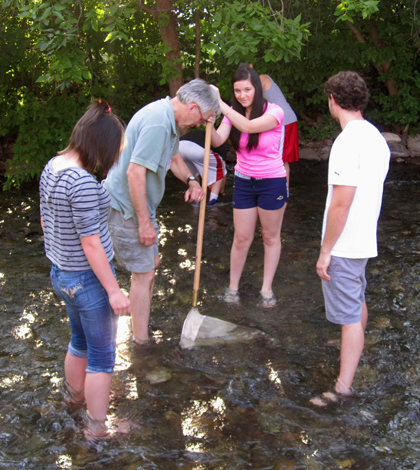Gallatin River watershed council monitors water quality in the nation’s headwaters

Stream Team volunteer Pat Costello teaches students with Big Sky Youth Empowerment to collect macroinvertebrates on Bozeman Creek. (Credit: Katherine Boyk)
Some portion of the water emptying into the Gulf of Mexico from the Mississippi River first passes through the Missouri River, which takes some of its flow from the Gallatin River near Three Forks, Montana.
The Gallatin watershed is part of a region sometimes called the headwaters of the nation for its place far upstream of the country’s major waterways. Though a healthy watershed is already vital to the rural agricultural lifestyle so prominent there, the people there have the added responsibility of being the first to see the water off on its journey to the Atlantic.
“It seems like people here realize that water quality is really important,” said Katherine Boyk, Big Sky Watershed Corps Member at the Greater Gallatin Watershed Council. “Partly because everyone relies on water for irrigation, but also because we are really in the headwaters.”
The Bozeman-based watershed council formed in 2004 to help channel new funding from the state Department of Environmental Quality for water quality monitoring to the Gallatin River watershed. Ten years later, the group leads volunteer monitoring on four streams and will soon submit a watershed restoration plan that will open up funding for improvement projects.
The volunteer stream teams monitor Bozeman Creek, Mandeville Creek, Matthew Bird Creek and the East Gallatin River. They collect samples for the lab and measure temperature, pH, specific conductivity and dissolved oxygen with a handheld YSI meter. The volunteers are trained on the instruments and follow a rigorous protocol set out by the DEQ.
“It’s not like it’s just volunteers messing around in the water,” Boyk said. “The data is being used for quite a bit of water quality assessment by the DEQ and the city of Bozeman and the county water quality agency.”

Stream Team volunteer Mark Story teaches students with Big Sky Youth Empowerment to measure discharge with an OTT Flow Meter on Bozeman Creek. (Credit: Katherine Boyk)
The volunteers also measure flow with an OTT MF pro Flow Meter that is new to to the council in 2013. The volunteers were previously using the float method, which Boyk says is fun but not very accurate.
“It’s great if you’re teaching kids, but if you’re trying to actually measure the load of nitrogen in the water it’s kind of limited,” she said.
The monitoring helps keep track of problems in the watershed, which include excess sediment- and nutrient-laden runoff that has landed 17 stream segments on a state list of impaired waters. Though the problems are largely related to agriculture, Bozeman’s rapid growth is leading to more storm water and urban runoff issues. Bozeman Creek, which runs through the heart of the city’s downtown, is one of two streams listed as impaired for E. coli bacteria.

Stream Team volunteers process Cholorphyll-a on the East Gallatin River to collect pre-restoration data at Story Mill Park. (Credit: Katherine Boyk)
The watershed council should soon have a little more muscle to address water quality issues in addition to monitoring them. Their first restoration projects are planned for next summer, including taking the lead on restoring wetlands and floodplain land around the historic Story Mill in Bozeman. The project has plenty of partners, but Boyk said its a huge step for a small nonprofit like the watershed council to head up such a big, visible effort.
It’s also chance for the council to show off what it can do and drum up public support for future work throughout the Gallatin watershed.
“The restoration projects only go so far as the public is interested,” Boyk said.
Top image: Stream Team volunteer Pat Costello teaches students with Big Sky Youth Empowerment to collect macroinvertebrates on Bozeman Creek. (Credit: Katherine Boyk)




0 comments